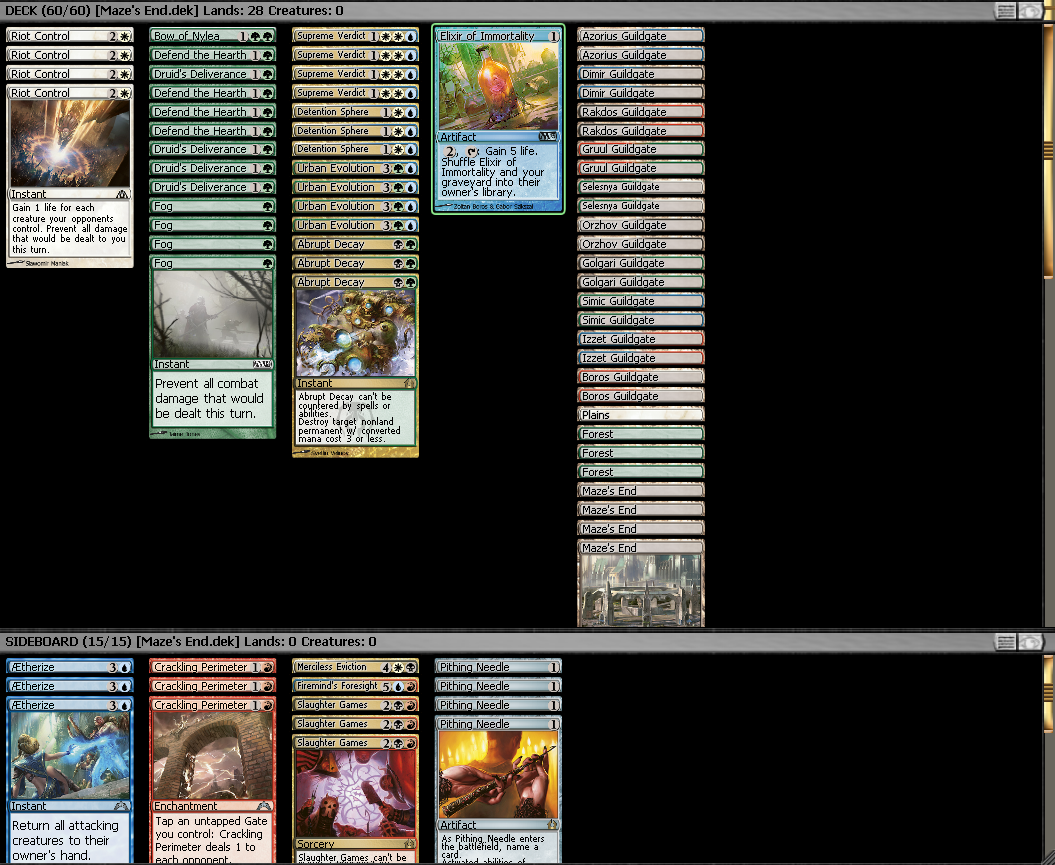My name was in the news this week!
Ok, not my name, but my family name. Semantics.
Peter Higgs and an unrelated contemporary, Francois Englert, both proposed a theory regarding a predicted subatomic particle called “the Higgs boson” in the 1960s, a theory which, for a layperson like myself, basically means we can tell why matter has mass. That’s a super-important discovery to be sure, and the way that these men were recognized this week is how we should look at the Magic deckbuilding process.
Both men attained this theory with their teams nearly simultaneously. This isn’t unusual; Galileo’s name is attached to the four largest moons of Jupiter, for example, but an independent astronomer, Simon Marius, discovered these moons at the same time. Although Galileo reported his findings slightly earlier, the names Marius chose for the quartet persist today. Both of their legacies last, though one lasts slightly more than the other.
As I’m sure you’ve encountered when building decks, a truly novel and exciting idea for a deck will come into your head and, when presented to your playgroup, at least one person always has to say, “Oh, I thought of something along those lines.” This shouldn’t be an excuse for us to balk at their discovery, but it should be thrilling; someone else has thought of something like mine, so maybe there’s something to it? We shouldn’t be so protective of our deck ideas; we can gain a lot by employing the help of others.
This week’s article is (mostly) filled with decks that I did not create, but are just edits I have applied to breakout decklists from my Magic neighbors. Thank you to each of my somewhat-inadvertent contributors this week!
The first deck to put through the Higgs engine is a relatively known archetype, Maze’s End.
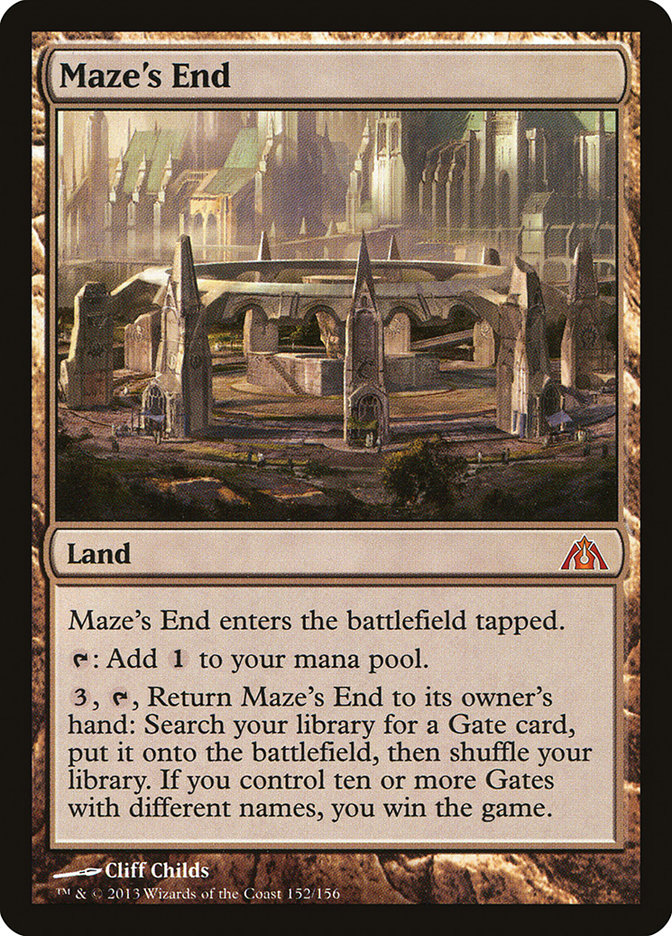
One of the first land-only win conditions in Magic, Maze’s End decks offer an uncounterable way to win the game at the cost of a very awkward and sluggish manabase. On the upside, every color is available to you, so long as you draw the right Guildgates. Maze’s End decks have been popping up in Standard and Block Constructed for months; what does Theros add to the mix?
My friend Cody is a fellow Magic junkie that hops shop to shop (anagram alert), playing pickup games and making laugh-worthy decks. Cody shared his recent build of a Maze’s End list during a session of Standard playtesting, and once we were finished he shared it with me. Though it’s a bit on memory, it looked something like this.
Lands (24)
Spells (36)

The sideboard is fuzzy, but I recall he had a set of Pithing Needles and three Slaughter Games.
Like any turbo-fog deck, you’re trying to stay alive as long as possible until you can stabilize, Wrath the board; while you’re doing this, you slowly extract each Gate from your deck. Crackling Perimeter makes quick work of planeswalkers and acts as a secondary win condition should something irreparable happen to one of your crucial Gates. Cody’s list packed two of each Gate, which was a first for me, and it sported Into the Wilds, a new addition to the deck.
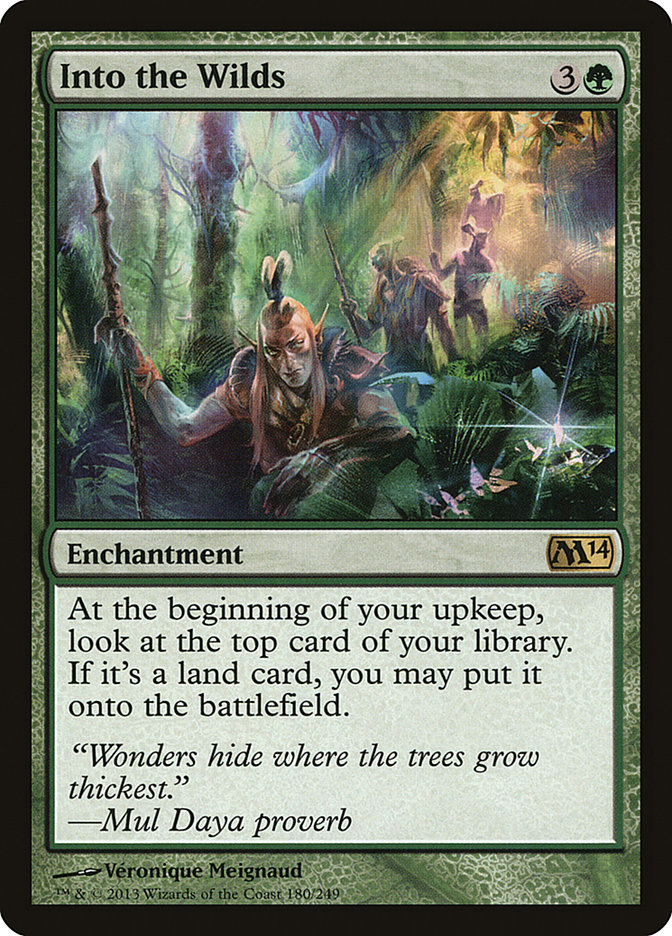
I joked on Cody for making this list from my own experience of facing Maze’s End decks in Block Constructed; they were the worst to play against. Pre-board, they are nearly impossible for most decks to interact with.
The deck’s cost is low, though; no shock lands or scry lands, and many of the rares are staples you probably have already anyway. I threw the list together online and took it for a spin with a few minor changes; I moved the Crackling Perimeters to the sideboard and maindecked Abrupt Decays in its place. I also added Bow of Nylea to the maindeck and removed Into the Wilds entirely (playtesting proved it to be underwhelming.) The sideboard kept the suite of Pithing Needles and a set of Slaughter Games, three Crackling Perimeters, three Aetherize and one Merciless Eviction.
TL:DR?
And yeah, I threw in a Firemind’s Foresight because it finds three Fogs. So sue me.
In testing, both Cody’s and my version of the deck played fine. It proved to be far more technical than I was expecting, requiring a significant amount of planning regarding land drops and Fog utilizations. With mono-red and R/X aggro being a major player in the online metagame, beatdown decks came on too strong in most situations. If you ever missed a Fog you were toast, and the Fogs were expensive enough that I couldn’t get ahead on the Gate front the turn I needed to use one. I’d have to play Gates tapped, take a hit, then Fog the next turn just to not die. And if they boarded in Skullcrack?

Against control, the deck played like a champ. Much of a control deck’s hand was dead, and even post-board the deck was able to recycle milled Gates with Bow of Nylea. Abrupt Decays proved to be great answers for early creatures and their post-board Pithing Needles. Even Ashiok, one of the deck’s toughest opponents, was not undefeatable. Plenty of removal and lockdown permanents kept it under control. One lengthy game against Esper Control ended with me managing a single-digit library, recycling milled Gates and finally finding my one remaining copy of Crackling Perimeter to finish my opponent off.
Aggro, though, is a difficult proposition. I considered revising the list to a completely different dynamic. Fogging every turn is just not fun (frankly, I’m not sure about the kind of folks who like Turbo-Fog,) so I moved away from that model for a bit of a different take.
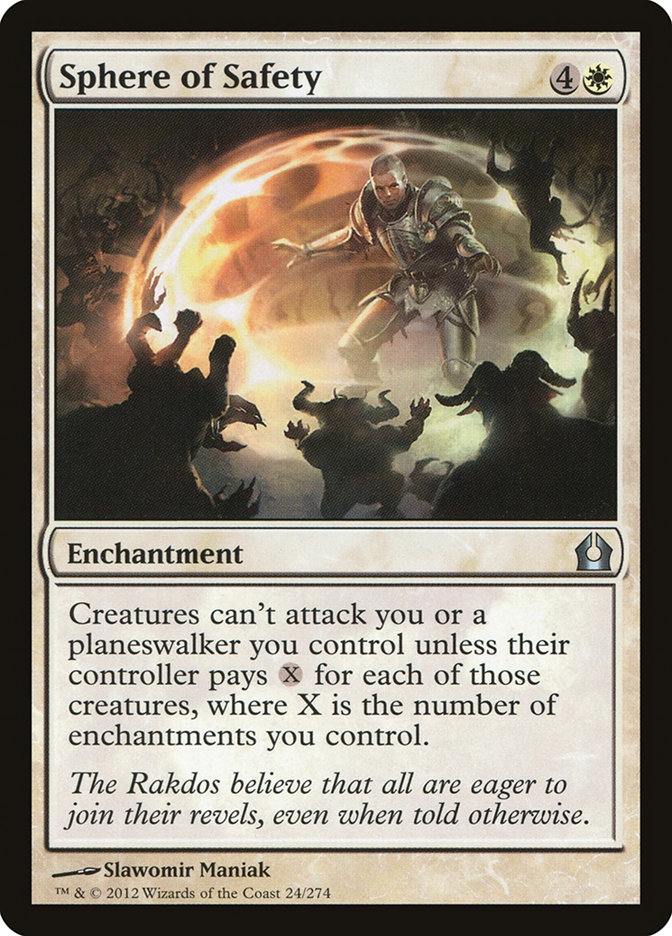
I can’t shake it. “For every” is a big Magic turn-on phrase for me, and this inflated Ghostly Prison could provide the permanent protection I needed to hang in the game. Let’s get chanting!
Creatures (2)
Lands (22)
Spells (36)
- 4 Plains
- 4 Fog
- 4 Supreme Verdict
- 4 Detention Sphere
- 4 Soul Tithe
- 4 Sphere of Safety
- 4 Urban Evolution
- 3 Blind Obedience
- 3 Crackling Perimeter
- 2 Bow of Nylea
Sideboard

With a bit of a mana-count retuning and a renovation of the prevention plan, we have another list to dissect!
An enchantment model looks better, with just the cheapest fog effect porting in from the other list. Blind Obedience can give you that extra turn against red haste as well as provide a slow alternate win condition. When you’re playing all your lands tapped, you want them to play their threats tapped, too. Soul Tithe, a card I’ve attempted to slide in a lot of places, is a bad card, yes, but it can be a very cheap Oblivion Ring or a Time Walk in the crucial first turns of the game. It was important to me that the deck has relevant early enchantments to add to the Sphere count as well as giving you something more exciting to do than just, “Fog. Fog. Riot Control. Urban Evolution with Druid’s Deliverance up.”
Bow of Nylea turned out to be a great tool in the previous iteration, and I’ve added another copy. Bow of Nylea helps you mitigate the turns when you don’t draw a Fog or pinpoint-removal enchantment, and it lets you scrape back up after a Wrath effect; I’m a big fan. Heliod, another new face, comes to play this time, too. Most of the enchantments and permanents in this deck are white, so there’s even a chance that he could become an enormous indestructible 5/6 monster. From the sidelines, he can still make Cleric chump blockers while you’re in topdeck mode.
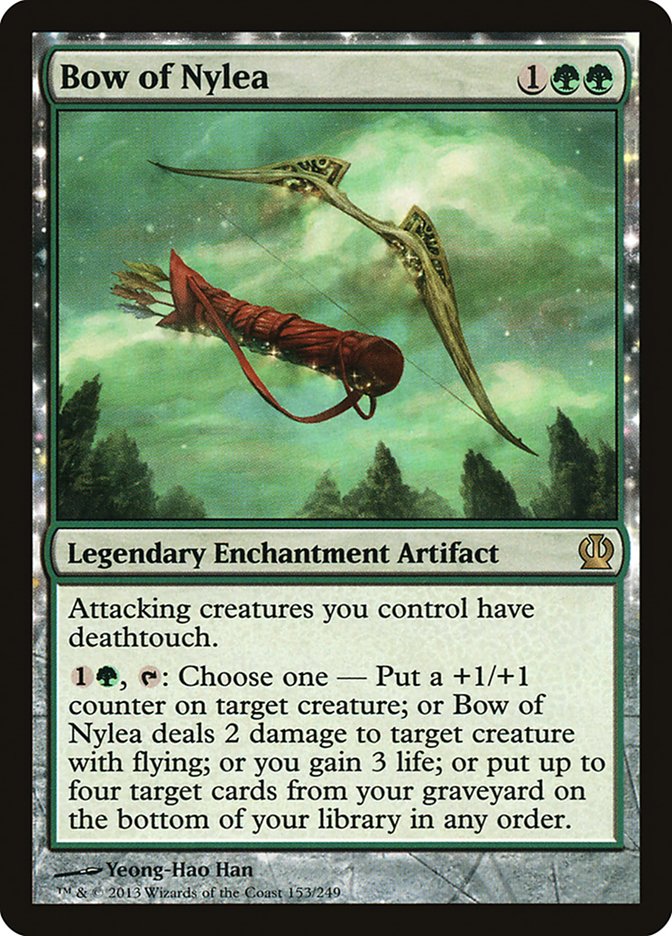
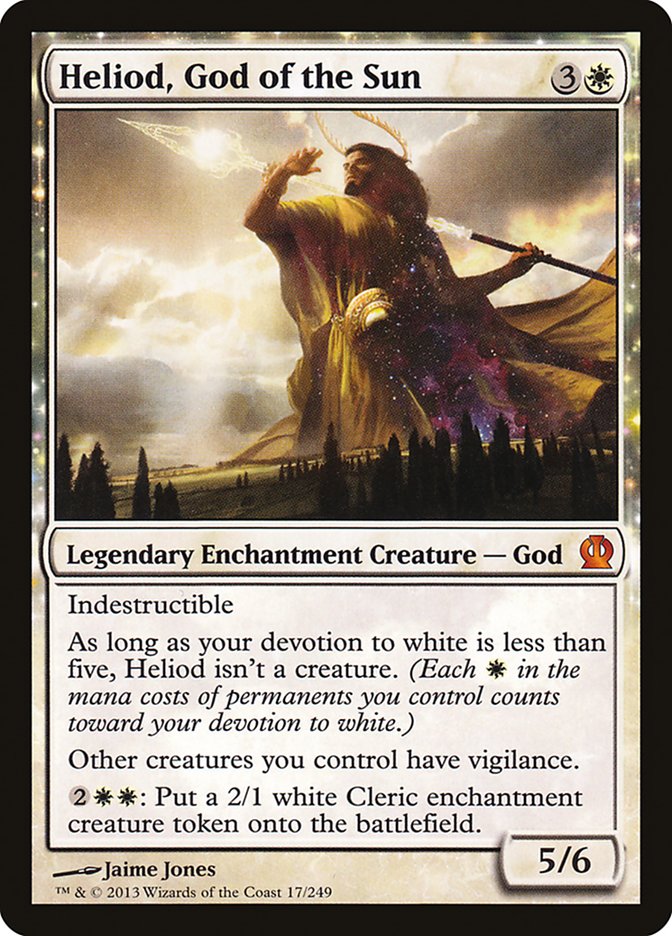
From the sideboard, Pacifisms come in to replace Urban Evolution against the aggro matchup, where you just won’t have a turn’s rest to tap out for one. Merciless Eviction, an undervalued Wrath, doubles up for this board; I’m not sure what application this card has, as six-mana Wrath effects rarely see play, but for the mana, this is one of the most versatile sweepers Standard supports. Hammer of Purphoros has a fun interaction internally; if you’ll notice, the Hammer makes enchantment artifact creatures, meaning that you will add to your Sphere count with each activation. There hasn’t been a way to make an enchantment token in… well, in ever, I guess. Now’s your chance! Sac those extra copies of Gates with your Hammer and shuffle them back in with your Bow!
This version remains untested, but may suffer from other problems that Sphere decks suffer from: consistency and mana issues. Maybe it’s worth a try? Either way, the first list is great for a control-heavy metagame, and this version is, in theory, better balanced against aggro, giving you semi-permanent answers for each threat your opponent plays.

The second list involves a long-time Magic companion and pal, Ben. Ben had a different outlook on Magic; first and foremost a collector, trader, and Eternal player, Ben has always provided interesting ideas and good conversation at the table. On a whim last week, he displayed a self-designed “brew” for playtesting. “Brew” might have a negative connotation in some circles, implying a weak or reaching deck that atrophies without its key combo or synergy piece.
Ben’s was not that.
He had muscled a deck of key players together to create a fun, high-pressure deck that offered aggro a new leg to stand on. Here’s what I know of his list.
Creatures (27)
- 4 Dryad Militant
- 4 Slitherhead
- 4 Rakdos Cackler
- 4 Deathrite Shaman
- 3 Purphoros, God of the Forge
- 4 Tormented Hero
- 4 Firedrinker Satyr
Lands (16)
Spells (17)

I didn’t get a chance to breeze through his sideboard, so that’s what I’ll hit regarding his deck. In his own words, he wanted to slam “every Savannah Lions Standard had” into a deck, then build a yard through Grisly Salvage and Commune with the Gods. Once you’ve swept away his team, Immortal Servitude on one mana utterly reverses the opponent’s work. With Purphoros out, your opponent is taking all that damage, plus you’ve been beating down with 2/1s since turn two. Pretty scary, right?
For the sideboard, we’d want to get some one-drops that serve a specific purpose, as well as protection against an opponent’s meddling. I propose a sideboard like this:
4 Golgari Charm
4 Festering Newt
3 Wasteland Viper
3 Pithing Needle
1 Bow of Nylea
Anger of the Gods is by far the biggest way to just flatten this deck. None of the crew can survive it, and they’ll be exiled too, turning Immortal Servitude into campfire fuel. Golgari Charm provides an easy, cheap answer to prevent disaster. Sliding in for either of the graveyard effects or even for a number of Servitudes, the Charm protects your team in these colors for just two mana. It also picks off some annoying enchantment, perhaps a Detention Sphere or even a wayward Rest in Peace (though that’s not really a card anymore), providing additional functionality. Its final function might be its most useful. At the end of your opponent’s turn, sweep your own team with the Shrivel effect, then reanimate them with Purphoros in play on your turn to get all those triggers back! Super combo breaker!
Pithing Needle deals with what I think might be another major deterrent to this deck: Scavenging Ooze. The Ooze can drain away a graveyard, all the while giving its controller life and a fat attacker that eats more 2/1s. Pithing Needle makes it ‘just’ a Grizzly Bear, and the Needle also deals with planeswalkers, Mutavaults, and other protections an opponent might utilize.
Festering Goblin, er, Festering Newt is a nice way to handle your opponent’s X/2s, making it sort of a Savannah Lions, right, Ben? Either way, it provides some additional removal in creature form that the deck can easily cast. Wasteland Viper, a cozy 1/2 deathtouch for one, acts as another speed bump against aggro or midrange builds. It has a funny way of dissuading attacks, and you can also attack and bloodrush with it, adding it to your graveyard and giving your attacker some more teeth or extra toughness that prevents a trade.
Speaking of teeth, I’ve brought the Bow again. Giving your Lions some venom lets you attack more profitably, even against an unfavorable board, and it stands in as graveyard preservation should an anti-graveyard card appear from your opponent’s grip. It shoots down flyers and pumps up a critter too, for what that’s worth, and Commune with the Gods has the option to grab it, preventing it from getting sloughed away in a mill.
Cody and Ben both had great ideas, and with work and collaboration, both have the potential to be enjoyable decks in the future!
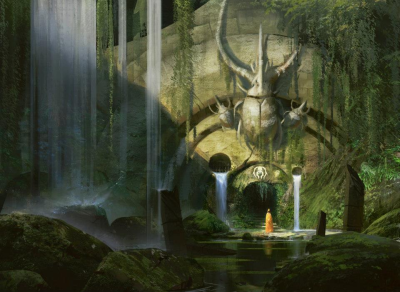
This weekend marks the first (and probably only) time Louisville has and ever will have its very own Grand Prix. I’m not complaining, though, and I have a different kind of control deck that will accompany me to the front lines. I’ll have that report next week, and I look forward to telling you about the experience.
Never stop innovating!
– Matt
CaptainShapiro on Magic Online

